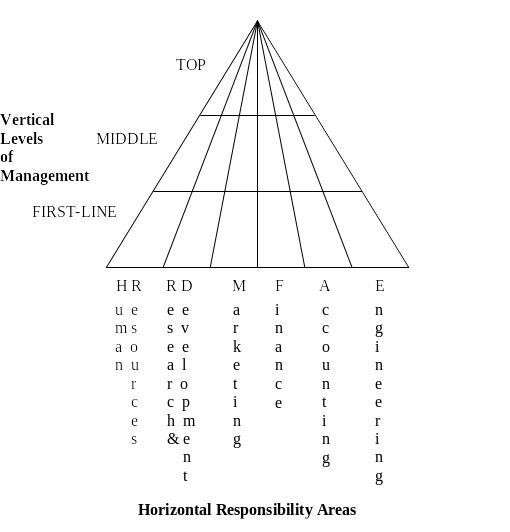
Unit 4
I. Information for study.
Прочтите и постарайтесь понять этот текст.
Managerial job types
Managerial jobs do vary somewhat on the basis of two important dimensions. One is a vertical dimension, focusing on different hierarchical levels in the organization. The other is a horizontal dimension, addressing variations according to the area for which managers have major responsibility.
Vertical Dimension: Hierarchical Levels

Along the vertical dimension, managerial jobs in organizations fall into three categories: first-line, middle, and top management. These categories can be viewed as vertical differentiation among managers because they involve three different levels of the organization.
First-Line Managers. First-Line Managers (or first-line supervisors) are managers at the lowest level in the hierarchy who are directly responsible for the work of operating (nonmanagerial) employees. They often have titles that include the word “supervisor”. First-line managers are extremely important to the success of an organization because they have the major responsibility of seeing that day-to-day operations run smoothly in pursuit of organizational goals.
Because they operate at the interface between management and the rest of the work force, first-line supervisors can easily find themselves in the middle of conflicting demands. At the same time, the power of first-line supervisors has been gradually eroding because of such factors as union influence and the increasing educational level of workers.
According to one recent review of research literature on first-line supervisors, the autonomy and influence of first-line managers is likely to ebb still further in the future. One reason is the increasing attempts by organizations to emulate the Japanese emphasis on worker participation in managing the work-place. Another is the trend toward work teams.
Still another is the use of computers to keep track of many activities formerly regulated by first-line managers. Finally, a growing number of specialists, particularly in fields involving sophisticated technology, provide advice and direction to work areas. One implication of these developments is that the job of the first-line supervisor is likely to change toward a greater emphasis on dealing with internal human relations and on representing the unit externally.
Middle Managers. Middle managers are managers beneath the top levels of the hierarchy who are directly responsible for the work of other managers below them. The managers for whom they have direct responsibility may be other middle managers or first – line managers. Middle managers also sometimes supervise operating personnel, such as administrative assistants and several specialists (such as engineers or financial analysts). Many different titles are used for middle managers. Some typical titles include such words as “manager”, “director of”, “chief”, “department head”, and “division head”. Middle managers are mainly responsible for implementing overall organizational plans so that organizational goals are achieved as expected.
Organizations, particularly very large ones, often have several layers of middle managers. For example, in recent years, giant General Motors has generally had about 14 or 15 management levels. That number reflects a post-World War II trend aimed at adding layers of middle management to help coordinate expanding activities. By the early 1980s, however, that trend began to reverse. At that point, many companies began cutting the number of levels of management hierarchy in an attempt to lower costs, reduce the layers involved in decision making, and facilitate communication.
One common result of having fewer layers is that the remaining middle-management levels gain greater autonomy and responsibility.
Top managers. Top managers are managers at the very top levels of the hierarchy who are ultimately responsible for the entire organization. Top-level managers are few in number; their typical titles include “chief executive officer” (CEO), “president”, “executive vice president”, “executive director”, “senior vice president” and sometimes “vice president”. Top-level managers are often referred to as executives, although the term “executive” also is sometimes used to include the upper layers of middle managers as well. Top managers have direct responsibility for the upper layer of middle managers. They typically oversee the overall planning for the organization, work to some degree with middle managers in implementing that planning, and maintain overall control over the progress of the organization.
